|
Each
of the overland trails crossing America from the Missouri River to the
mountains had a story. It's a story written deep in the lives of men and
women. It's a story written in broad furrows across the prairies. Along
these trails journeyed thousands of men, women, and children with ox
teams, carts, wheelbarrows, and on foot, to settle the frontier. Over them
marched the soldiers who built forts to protect the settlers. Then the
long freight trains loaded with food, tools, and clothing passed that way.
Soon there came to be great beaten thoroughfares one or two hundred feet
wide, deeply cut into the earth by the wheels of wagons and the feet of
the emigrants. Such is the drama of the Oregon Trail, the trail of the
greatest mass migration in human history.
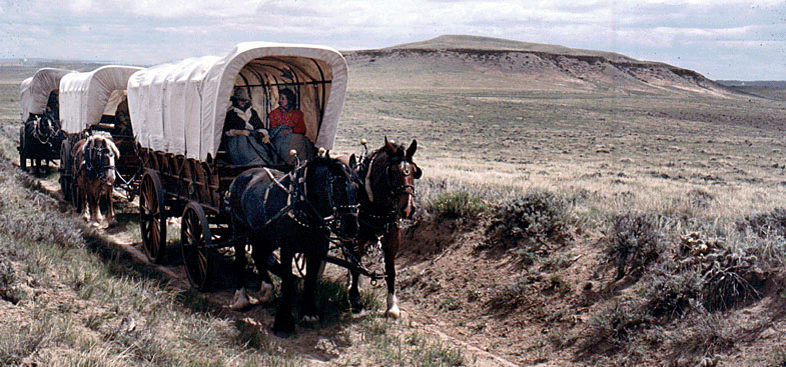
The Oregon Trail traversed 1,932 miles of prairie and
wilderness across North America. Cut-offs were developed over the years
that shortened the distance by up to 75 miles. From Courthouse Square in
Independence, Missouri, to Oregon City on the Willamette River, it passed
through the present-day states of Missouri, Kansas, Nebraska, Wyoming,
Idaho, and Oregon.
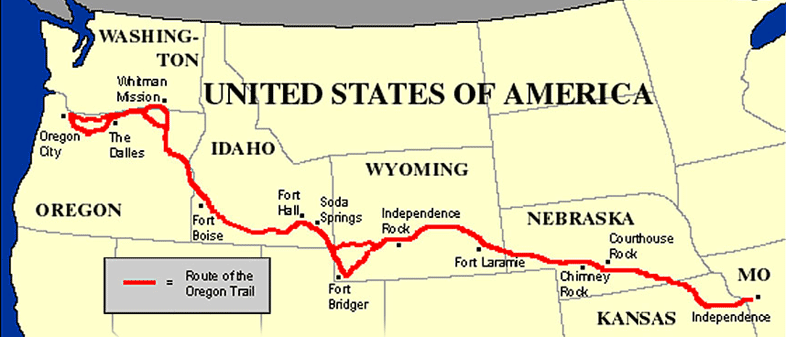
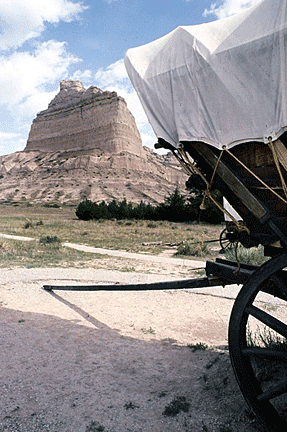 A common misconception is the route, itself. It's often
believed to be one road that never changed. More likely it's believed to
be a vague route over which a solitary wagon or perhaps a small wagon
train traveled alone, breaking new ground and never knowing where they
were. This is Hollywood's version. In reality the Trail meandered across
the plains like a braided band frayed at both ends, changing each year. A common misconception is the route, itself. It's often
believed to be one road that never changed. More likely it's believed to
be a vague route over which a solitary wagon or perhaps a small wagon
train traveled alone, breaking new ground and never knowing where they
were. This is Hollywood's version. In reality the Trail meandered across
the plains like a braided band frayed at both ends, changing each year.
At some places, such as Robidoux's Pass near Scott's
Bluff, Nebraska, wagons converged into a single lane. At others, they
spread out over a half mile or more in parallel lanes. No one journeyed
out onto the plains alone. They joined their relatives, friends, and
neighbors to form wagon companies for mutual safety and protection. During
peak years, other companies were hours or at most a day away.
The trip took six months to complete. Emigrant wagon
trains would leave Missouri each spring, as soon as there was enough new
grass to feed their animals. They also had to cross the western mountains
before early snowfalls closed the passes.
With heroic effort and optimum conditions, emigrants
might have made 40 miles in one day, but most of the time they made only
15, reaching Oregon in four and a half months. Contrary to the Hollywood
image, most people walked because their wagons were full of supplies and
furnishings needed to
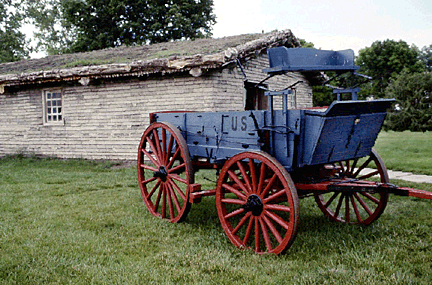 establish their new homes in Oregon. Some didn't
have wagons at all and rode horseback. Some reported seeing others riding
on cows for a part of the journey. Mules and oxen were better suited for
the Trail, as horses needed feed. establish their new homes in Oregon. Some didn't
have wagons at all and rode horseback. Some reported seeing others riding
on cows for a part of the journey. Mules and oxen were better suited for
the Trail, as horses needed feed.
Historically, the Conestoga wagon, originating in
eastern Pennsylvania, has always been associated with the great migration.
Artists have pictured it as used by the emigrants, but of all the wagons
gathered at Independence, there were none. They were far too heavy for
overland travel on the Trail. The typical "prairie schooner" was
nothing more than a flat-bed Murphy farm wagon masquerading under a tilt
of waterproof Osnaburg sheeting.
Who Traveled the Trail
A cross-section of mid-nineteenth century
American society traveled the Trail. Businessmen, professionals,
politicians, journalists, adventurers, missionaries, gamblers, miners,
freighters, and especially farmers, endured the hardships together. Few
were men of means and fewer still were fitted by their previous occupation
--clerks, shopkeepers, mechanics--for the rigors of the Trail.
Journalists of the time called this migration "the
greatest crowd of adventurers since the invasion of Rome by the
Goths." It was a grand spectacle in the style of Cecil B. DeMille,
worthy of an epic motion picture.
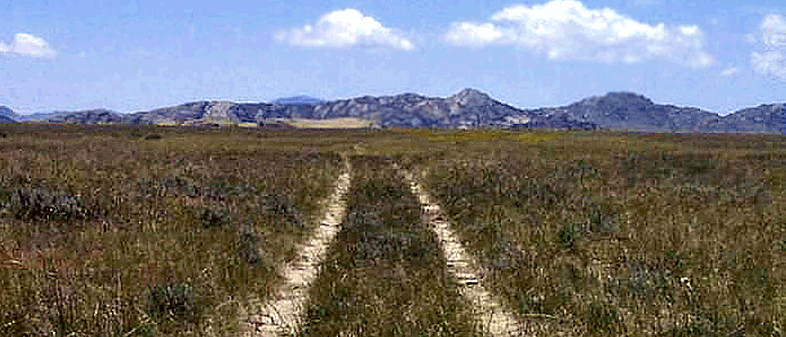
The plains were rough back then. Emigrants saw nothing
but miles and miles of prairie grass. Millions of buffalo roamed the wide
landscape. When the emigrants arrived at Ash Hollow, near Lewellen,
Nebraska, it was as if they had come to an oasis in the desert. But before
they could taste the sweet spring water and sit in the shade of the ash
trees, they had to descend Windlass Hill, an almost perpendicular grade.
Originally all streams and rivers had to be forded. But
within a few years, bridges and ferries were established along the way.
Often emigrants, after building a raft for themselves, would ferry other
wagons across a river for a fee. The average fee was three dollars per
wagon. From this two enterprising entrepreneurs made $65,000 in 1852.
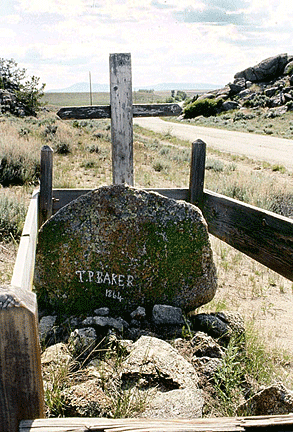 Historians estimate one-in-ten to one-in-seventeen died
along the way, although accurate records don't exist. Disease was the main
killer. Asian cholera, of epidemic proportions in the United States in the
mid-1860s, followed the emigrants along the Trail. To combat the disease,
they ingested a solution of cornmeal and raw whiskey. Many downed great
quantities of medicine at the first sign of illness-- the larger the dose
the quicker the recovery. As a result, many died of overdoses. Accidents
involving livestock, wagons, firearms and river crossings were the second
major cause of death. Indians, contrary to myth, weren't a problem. Historians estimate one-in-ten to one-in-seventeen died
along the way, although accurate records don't exist. Disease was the main
killer. Asian cholera, of epidemic proportions in the United States in the
mid-1860s, followed the emigrants along the Trail. To combat the disease,
they ingested a solution of cornmeal and raw whiskey. Many downed great
quantities of medicine at the first sign of illness-- the larger the dose
the quicker the recovery. As a result, many died of overdoses. Accidents
involving livestock, wagons, firearms and river crossings were the second
major cause of death. Indians, contrary to myth, weren't a problem.
In fact, Hollywood usually shows the typical wagon train
gathering in a circle as protection against Indian attack. While this may
have occurred during the 1880s after the great migration and during the
Indian wars, wagon trains originally gathered to create a corral for their
livestock. Most occupants slept outside the circle in tents or on the
ground under the star-lit sky.
Indians on their pinto ponies, some dragging laden
travois, frequently rode by, gazing curiously at the ox-drawn wagons.
Often they stopped to swap robes, buckskin, Indian-made moccasins, fringed
shirts and leggings, for whatever the pioneers had to offer.
The Emigrant Road
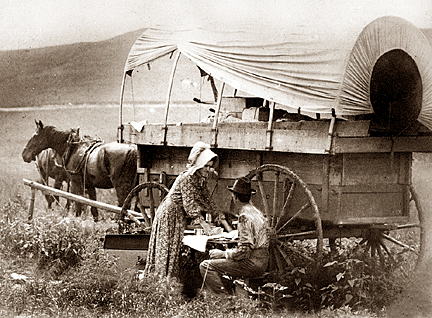 Originally called "The Emigrant Road,"
the route became known as "The Oregon Trail" following the
publication of Francis Parkman's best-selling novel of the same name in
1848. Originally called "The Emigrant Road,"
the route became known as "The Oregon Trail" following the
publication of Francis Parkman's best-selling novel of the same name in
1848.
Residents of the eastern United States during the early
nineteenth century were less informed and more naive about what lay west
of the Mississippi River than were scientists of the mid-twentieth century
about what lay on the Moon.
The Missouri Gazette of St. Louis of May 15, 1823,
said,"...it appears that a journey across the continent of North
America, might be performed by wagon, there being no obstruction in the
whole route that any person would dare to call a mountain."
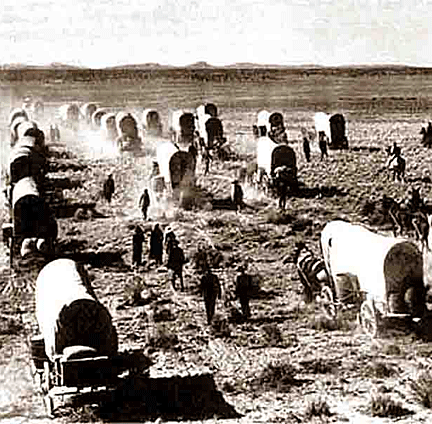 More than two decades were to pass before the first
wagon passed over the Oregon Trail all the way from the Mississippi Valley
to the Columbia River, and three decades before the first wagon traveled
all the way to the great central valley of California. More than two decades were to pass before the first
wagon passed over the Oregon Trail all the way from the Mississippi Valley
to the Columbia River, and three decades before the first wagon traveled
all the way to the great central valley of California.
There were five periods in the story of the Oregon
Trail. The first was the period of finding the way and breaking the trail
ending in 1832. The second period was that of the early Oregon migration
and extends to 1849 and the discovery of gold in California. The third
period was that of the Gold Rush climaxing in 1860. During this period,
the Trail became the greatest traveled highway in the world, wider and
more beaten than a city street, as over 350,000 pioneers passed over it.
The fourth period saw its decline and the fifth its eventual effacement.
Westward Expansion
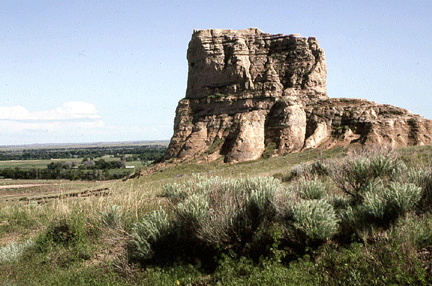 The Oregon Trail opened at a time in history
when the westward expansion of the United States has stalled at the
Missouri River. Mexico still claimed all of California, and Alaska was a
Russian territory. Everything from California to Alaska and between the
Rocky Mountains and the Pacific Ocean was a British-held territory called
Oregon. The Trail allowed the United States to expand west through Oregon
and achieve its national "manifest destiny" to reach from
"sea to shining sea" by sheer force of population. The Oregon Trail opened at a time in history
when the westward expansion of the United States has stalled at the
Missouri River. Mexico still claimed all of California, and Alaska was a
Russian territory. Everything from California to Alaska and between the
Rocky Mountains and the Pacific Ocean was a British-held territory called
Oregon. The Trail allowed the United States to expand west through Oregon
and achieve its national "manifest destiny" to reach from
"sea to shining sea" by sheer force of population.
The best description of the Oregon Trail is that of
Father De Smet, a Jesuit priest who set out to establish missions among
the Indians. He tells of its appearance when first seen by him and his
party of Indians from the Upper Missouri in 1851:
"Our Indian companions, who had never seen but the
narrow hunting paths by which they transport themselves and their lodges,
were filled with admiration on seeing this noble highway, which is smooth
as a barn floor swept by the winds, not a blade of grass can shoot up on
it on account of the continual passing...They styled the route the 'Great
Medicine Road of the Whites.'"
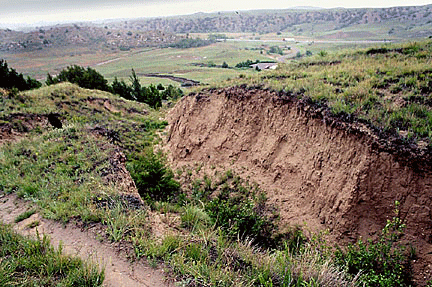 But Father De Smet was not the only one to describe the
Trail. It's believed that one in two hundred emigrants kept a diary. In
these personal accounts, they told of torrential downpours, hailstorms,
flooding of streams, muddy roads, snakes and mosquitoes, breakdowns, oxen
with bad feet, the heat of day and the cold of night, as well as buffalo
stampedes. But Father De Smet was not the only one to describe the
Trail. It's believed that one in two hundred emigrants kept a diary. In
these personal accounts, they told of torrential downpours, hailstorms,
flooding of streams, muddy roads, snakes and mosquitoes, breakdowns, oxen
with bad feet, the heat of day and the cold of night, as well as buffalo
stampedes.
It's through these diaries that the Oregon Trail remains
alive today. The realities of mid-nineteenth century travel are made all
too evident through demonstrations and living history programs at most of
the interpretive sites along the way. Physical evidence--deep wagon ruts,
graffiti, and gravesites--of the Oregon Trail is most visible in Wyoming.
< Back to
History Articles
Go to next History article >
|
